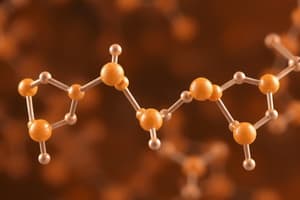Podcast
Questions and Answers
In an alpha-amino acid, what is the specific relationship between the amino and carboxyl groups?
In an alpha-amino acid, what is the specific relationship between the amino and carboxyl groups?
- They are part of a cyclic structure within the molecule.
- They are both bonded to the same alpha-carbon atom. (correct)
- They are located on opposite ends of the molecule.
- They are attached to adjacent carbon atoms in the chain.
Which structural characteristic defines an alpha-amino acid?
Which structural characteristic defines an alpha-amino acid?
- The presence of a sulfur atom in the side chain.
- The presence of a hydroxyl group attached to the alpha-carbon.
- The attachment of both an amino and a carboxyl group to the same carbon atom. (correct)
- The direct bonding of an amino group to a carboxyl group.
If a molecule is described as an alpha-amino acid, what must be true about its structure?
If a molecule is described as an alpha-amino acid, what must be true about its structure?
- It has an amino group on one end and a carboxyl group on the opposite end.
- It contains a peptide bond.
- It has both an amino group and a carboxyl group bonded to the same carbon atom. (correct)
- It contains at least two carboxyl groups.
How does the position of the amino and carboxyl groups in alpha-amino acids affect their properties?
How does the position of the amino and carboxyl groups in alpha-amino acids affect their properties?
What is the significance of the 'alpha' designation in the term 'alpha-amino acid'?
What is the significance of the 'alpha' designation in the term 'alpha-amino acid'?
Under what physiological conditions might Arginine be considered an essential amino acid?
Under what physiological conditions might Arginine be considered an essential amino acid?
Which of the following amino acids can be converted into ketone bodies?
Which of the following amino acids can be converted into ketone bodies?
A patient with uncontrolled diabetes is experiencing ketoacidosis. Which amino acid, when metabolized, would directly contribute to the production of ketone bodies, exacerbating this condition?
A patient with uncontrolled diabetes is experiencing ketoacidosis. Which amino acid, when metabolized, would directly contribute to the production of ketone bodies, exacerbating this condition?
An individual is on a very low-carbohydrate diet to lose weight. Which of the following metabolic fates of amino acids becomes most relevant in providing an alternative energy source for the brain?
An individual is on a very low-carbohydrate diet to lose weight. Which of the following metabolic fates of amino acids becomes most relevant in providing an alternative energy source for the brain?
A researcher is studying the metabolic pathways of different amino acids. They want to investigate which amino acids can contribute to both glucose and ketone body production under different metabolic conditions. Based on the provided information, which single amino acid would be MOST suitable for this study?
A researcher is studying the metabolic pathways of different amino acids. They want to investigate which amino acids can contribute to both glucose and ketone body production under different metabolic conditions. Based on the provided information, which single amino acid would be MOST suitable for this study?
What is the primary function of glutathione within cells?
What is the primary function of glutathione within cells?
Which cellular process is directly supported by the antioxidant properties of glutathione?
Which cellular process is directly supported by the antioxidant properties of glutathione?
In what way does glutathione contribute to the detoxification process in cells?
In what way does glutathione contribute to the detoxification process in cells?
How does glutathione's function as an antioxidant relate to maintaining overall cellular health?
How does glutathione's function as an antioxidant relate to maintaining overall cellular health?
If a cell's ability to produce glutathione were significantly impaired, which of the following consequences would be most likely?
If a cell's ability to produce glutathione were significantly impaired, which of the following consequences would be most likely?
Flashcards
What are alpha-amino acids?
What are alpha-amino acids?
Amino acids with amino and carboxyl groups attached to the same carbon atom.
What is the alpha-carbon?
What is the alpha-carbon?
The carbon atom to which both the amino and carboxyl groups are attached in alpha-amino acids.
What is an amino group?
What is an amino group?
A chemical group consisting of a nitrogen atom bonded to two hydrogen atoms (-NH2).
What is a carboxyl group?
What is a carboxyl group?
Signup and view all the flashcards
Most important type of amino acids?
Most important type of amino acids?
Signup and view all the flashcards
Semi-Essential Amino Acids
Semi-Essential Amino Acids
Signup and view all the flashcards
Arginine (Arg)
Arginine (Arg)
Signup and view all the flashcards
Ketogenic Amino Acids
Ketogenic Amino Acids
Signup and view all the flashcards
Glucogenic Amino Acids
Glucogenic Amino Acids
Signup and view all the flashcards
Examples of Ketogenic Amino Acids
Examples of Ketogenic Amino Acids
Signup and view all the flashcards
What is an antioxidant?
What is an antioxidant?
Signup and view all the flashcards
What is glutathione?
What is glutathione?
Signup and view all the flashcards
What is oxidative stress?
What is oxidative stress?
Signup and view all the flashcards
What is detoxification?
What is detoxification?
Signup and view all the flashcards
What are the main functions of Glutathione?
What are the main functions of Glutathione?
Signup and view all the flashcards
Study Notes
-
Amino acids are the building blocks of proteins
-
Amino acids have a carboxyl group (-COOH), an amino group (-NH2), a hydrogen atom (-H), and a unique side chain (R group)
-
Alpha-amino acids are the most important, with amino and carboxyl groups attached to the alpha-carbon
-
There are over 300 amino acids in nature, but only 20 are essential for making proteins
-
Some amino acids have their amino and carboxyl groups on different carbons
Classification of Amino Acids
- Amino acids can be classified based on chemical structure, nutritional or biological function, and metabolic fate
Classification I - Chemical Structure
- Chemical structure classification is based upon the amino acid side chain
- Nonpolar, Aliphatic amino acids include Glycine, Alanine, Valine, Leucine, and Isoleucine
- Aromatic Amino Acids include Phenylalanine, Tryptophan (essential), and Tyrosine (non-essential)
- Sulfur-containing amino acids are Methionine and Cysteine
- Methionine is one of the essential amino acids
- Hydroxyl-containing amino acids are Serine and Threonine, Threonine is an essential amino acid
- Acidic amino acids are Aspartate and Glutamate, they are non-essential amino acids
- Amidic amino acids are Asparagine and Glutamine, they are non-essential amino acids
- Basic amino acids are Arginine, Lysine, and Histidine, they are all charged and essential amino acids
- The imino acid is Proline; it is non-essential
Classification II - Nutritional or Biological Function
- Nutritional or biological function classification is based depending on whether the amino acids can be synthesized in the body
- Essential Amino Acids: Cannot be synthesized by the body and must be obtained from the diet, including Phenylalanine, Valine, Threonine, Tryptophan, Isoleucine, Methionine, Histidine, Arginine, Lysine, and Leucine
- Non-Essential Amino Acids: Can be synthesized by the body and are not essential in the diet, including Glycine, Cysteine, Alanine, Tyrosine, Serine, Glutamine, Asparagine, Spartate and Glutamate
- Semi-Essential Amino Acid: Essential during periods of growth, stress, or illness, including Arginine
Classification III - Metabolic Fate
- Metabolic fate classification is based upon the fate of amino acid inside the body
- Ketogenic Amino Acids: Amino acids that can be converted into ketone bodies, including Leucine and Lysine
- Glucogenic Amino Acids: Amino acids that can be converted into glucose
- Mixed Amino Acids: Amino acids that can be converted into both glucose and ketone bodies, including Phenylalanine, Isoleucine, Tyrosine, and Tryptophan
Uncommon Amino Acids
-
Uncommon amino acids are, not one of the 20 fundamental amino acids, and are derived from post-translational modifications or unique synthesis processes
-
They are important, because they play critical roles in protein function, structure, and biochemical pathways.
-
4-Hydroxyproline; Derived from Proline; Stabilizes collagen structure; Found in collagen
-
5-Hydroxylysine; Derived from Lysine; involved in collagen cross-linking; Found in collagen
-
6-N-Methyllysine; Derived from Lysine; Component of contractile proteins; Found in myosin
-
γ-Carboxyglutamate; Derived from Glutamate; Binds calcium in blood clotting proteins; Found in prothrombin (clotting factor)
-
Selenocysteine is the 21st amino acid with selenium instead of sulfur, derived from serine and introduced during protein synthesis
-
Selenocysteine is found in active sites of oxidation-reduction enzymes
-
Ornithine and Citrulline are intermediate in the urea cycle and play a key role in nitrogen metabolism
Properties of Amino Acids
-
All amino acids are alpha-amino acids
-
The amino group is attached to the alpha carbon
-
Glycine is the only amino acid without an asymmetric alpha carbon
-
Alpha Carbon: Asymmetric except glycine
-
L-Amino Acids are found in proteins
-
D-Amino Acids are found in some bacterial products
-
Glycine is not optically active
-
Amino acids have both acidic (COOH) and basic (NH2) groups and can act as both acids and bases depending on the pH
-
At the isoelectric point (pI), an amino acid has no net charge.
-
The COOH group is negatively charged, and the NH2 group is positively charged
-
Zwitterion: A molecule with both positive and negative charges
Effects of pH on Amino Acid Behavior
-
At Low pH (Acidic): High hydrogen ion (H+) concentration and both amino and carboxyl groups are protonated
-
At Neutral pH: Amino acid exists as a zwitterion with NH3+ (positively charged) and COO- (negatively charged)
-
At High pH (Basic): Low hydrogen ion (H+) concentration and both the amino and carboxyl groups lose protons
-
In addition to their role as building blocks of proteins and peptides, amino acids serve a variety of functions.
-
Glycine: Detoxification and Synthesizes heme
-
Methionine: Methyl donor in metabolism
-
Tyrosine: Synthesizes thyroid hormones (T3, T4), epinephrine, norepinephrine, and melanin
-
Tryptophan: Synthesizes niacin (Vitamin B3) and serotonin
-
Histidine: Synthesizes histamine
-
Aspartate and Glutamine: Involved in pyrimidine synthesis
-
Glycine, Aspartic Acid, Glutamine: Involved in purine synthesis
Introduction to Proteins
-
Proteins (polypeptides) are polymers of amino acids, linked by peptide bonds
-
Their structure and function are dictated by the sequence of amino acids
-
They play crucial roles in various biological processes
-
Peptides range in size from two to many thousands of amino acids
-
Biological activities aren't always related to size or molecular weight.
-
Even small peptides can have significant biological effects
-
Example: Aspartame (dipeptide L-aspartyl-L-phenylalanine methyl ester), a low-calorie artificial sweetener.
Examples of Small Peptides
- Oxytocin: 9 amino acids, stimulates uterine contractions during childbirth
- Bradykinin: 9 amino acids, inhibits inflammation and mediates pain
- Thyrotropin-Releasing Factor: 3 amino acids. stimulates the release of thyroid-stimulating hormone (TSH) from the pituitary.
- Gluthathione: 3 amino acids, is an antioxidant, protects cells from oxidative stress
- Amanitin (toxic peptide): 8 amino acids, inhibits RNA polymerase in cells, leading to cell death
- Gramicidin A (antibiotic): Variable amino acids. disrupts bacteria cell membranes, leading to bacterial cell death.
Examples of Slightly Larger Peptides and Oligopeptides
- Insulin: 51 amino acids. regulates glucose metabolism by promoting glucose uptake in cells
- Glucagon: 29 amino acids, raises blood glucose levels by stimulating glycogen breakdown
- Corticotropin: 39 amino acids. stimulates the adrenal cortex to release cortisol in response to stress
Proteins
- Proteins are long chains of amino acids with specific sequences.
- Their structure is directly influenced by the gene sequence.
- Even a single amino acid change can alter function (e.g., sickle cell anemia)
Classifications of Proteins
- Proteins can be classified based on function, shape, and composition
Classification based on Shape
- Globular Protein: spherical, compact, water-soluble, less stable, biologically active
- Examples: Insulin, Myoglobin, Antibodies, Enzymes
- Fibrous Protein: linear, structural, insoluble in water, more stable
- Examples: Keratin, Collagen, Elastin, Myosin
Classification Based on Function
- Transport Function: Proteins that transport molecules across the body, for example Hemoglobin, Transferrin
- Catalytic Function: Enzymes speed up biochemical reactions, for example Lactase, Pyruvate kinase
- Storage Function: Store vital molecules for later use, for example Myoglobin, Ferritin
- Defense Function: Proteins involved in the immune defense, for example Immunoglobulins
More Functions of Proteins
- Structural Function: Provides structure, strength, and elasticity, for example Collagen, Keratin
- Nutrient Function: Provides nutrients for biological systems, for example Casein, Albumin
- Infective Agents: Prions act as infective proteins causing disease, for example Prions
- Buffering Function: Plasma proteins act as buffers to maintain pH balance, for example Albumin, Haptoglobin
- Gene Expression: Involved in gene regulation and packaging, for example Histones, Nucleoproteins
- Regulatory Function: Controls physiological processes through protein hormones, for example Insulin, Hormone receptors
Classification Based on Composition
- Simple proteins: Proteins are composed only of amino acids, for example Albumins and Globulins
- Derived proteins: Proteins are derived from simple or complex proteins after hydrolysis or denaturation, for example Casein and Peptones
- Complex proteins: Proteins are made from amino acids combined with non-protein parts, for example Glycoproteins and Metalloproteins
Conformation of Proteins
- Proteins have unique three-dimensional structures, known as their conformation
- Their function is determined by this structure
- Proteins have four structural levels; primary, secondary, tertiary, and quaternary
Primary Structure
- The sequence of amino acids in a polypeptide chain.
- Held together by peptide bonds
- Determines the protein's final structure and function
- Starts with the N-terminal amino acid (free amino group) and ends with the C-terminal amino acid (free carboxyl group).
- The protein sequence is read from left to right
- The remaining amino acids in the chain are called amino acid residues
Secondary Structure
- Local folding of the polypeptide chain into structures.
- Alpha helix: Right-handed spiral, stabilized by hydrogen bonds.
- Beta sheet: Extended structure with hydrogen bonds between chains
Secondary Structure: α-helix
- It is a spiral structure with peptide bonds coiled tightly inside and side chains sticking out.
- It is a right-handed helix (coils turn clockwise), which is more stable than the left-handed version.
- There are 3.6 amino acids per turn of the helix.
- a-helices are usually found inside the protein structure.
- The a-helix is stabilized by hydrogen bonds within the chain (intra-chain).
- These bonds are individually weak, but together, help keep the helix stable
Secondary Structure: β-pleated sheet
- ẞ-pleated sheet: A more extended structure than the a-helix.
- The structure is pleated because the C-C bonds are tetrahedral and can't be straight.
- Stabilized by hydrogen bonds between NH and C=O of adjacent peptide segments.
- The segments may run in the same direction (parallel ẞ-sheet) or in opposite directions (antiparallel ẞ-sheet).
- Beta bends (U-turns in the chain) are stabilized by disulfide bridges.
- In an antiparallel ẞ-sheet, the chains are oriented in opposite directions, and the amino acid side chains alternate above and below the plane of the sheet.
- Hydrogen bonding occurs between different chains (interchain bonding)
Tertiary Structure
- The overall 3D folding of a protein. Cysteine
- Influenced by covalent bonds and noncovalent bonds (hydrophobic forces, ionic bonds, and hydrogen bonds).
- Hydrophobic side chains in the interior, and hydrophilic side chains on the exterior
Quaternary Structure
-
Arrangement of multiple polypeptide chains in a protein.
-
Not all proteins have a quaternary structure.
-
Each polypeptide chain is called a subunit, and it has its own primary, secondary, and tertiary structure.
-
The polypeptide chains are held together by the same forces that stabilize tertiary structure
-
Monomer: 1 subunit
-
Dimer: 2 subunits
-
Tetramer: 4 subunits
-
Example: Insulin is made up of two subunits, linked by two disulfide bridges
-
Haemoglobin is a tetramer made up of two identical dimers
-
Quaternary structure of haemoglobin is tightly held together by hydrophobic interactions
Types of Polymers
- A homopolymer is made up of identical subunits.
- A heteropolymer is made up of different subunits.
- Insulin is a heteropolymer.
Proteins are classified based on function, shape, and composition
- Protein structure determines function.
- Classification helps to understand diverse biological roles.
Studying That Suits You
Use AI to generate personalized quizzes and flashcards to suit your learning preferences.



